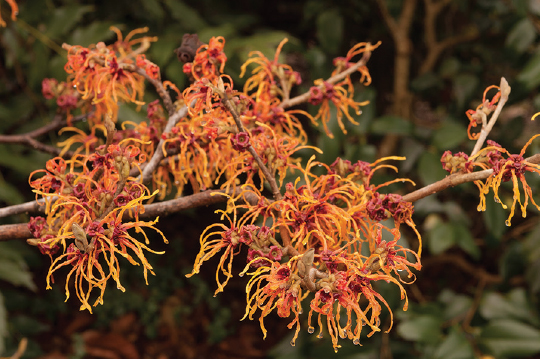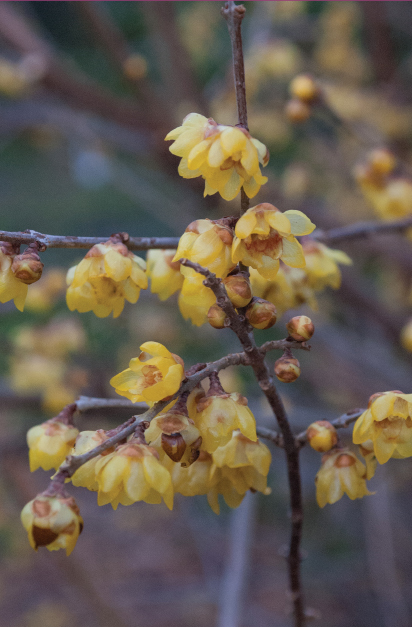By January, dedicated green thumb gardeners begin yearning for something, anything, growing in the landscape that hints of the coming spring, which is still many, many weeks away. One plant that readily comes to the rescue is wintersweet, an unusual shrub that bears its brave flowers during these coldest times of the year.
Shaped like small butter-colored bells, wintersweet’s blooms are, indeed, a welcome sight in January’s garden that is comforting to the eyes. But as an unexpected bonus, these blossoms are also a veritable feast for the nose.
While the flowers are modest in appearance, they fill the chilled air with a marvelous, sweet scent that surprises many gardeners not expecting such a treat until roses, gardenias, heliotropes and other similarly fragrant flowers start their shows in the warmer months, long after winter has become a memory.
Botanically known as — take a deep breath if you are going to try to pronounce it — Chimonanthus praecox, wintersweet is a shrub that can grow 10 to 12 feet high and just about as wide if left unpruned.
It has a loose, multi-branched habit with deciduous, glossy-green, lance-shaped leaves, which turn a modest light yellow with the arrival of autumn. In short, not a growing season specimen plant, but this shrub certainly should be placed close to paths, entryways and other frequently-visited areas to take best advantage of its pleasing, surprisingly scented winter flowers.
Wintersweet adapts to many soil types but does best in moderately well-drained sites. And for maximum cold season flower power, plant in full sun. A pruning every few years after the blossoms are spent will also encourage more blooms in winters to come.
Indoor Blooms Too
There is also an advantage to lightly pruning wintersweet before this shrub blooms: cut branches can be forced into flower earlier indoors. Snip a few shoots about 12 to 18 inches long, bring inside, and soak them in warm water overnight. Then place the branches in a vase that is away from sunlight, change the water weekly, and when the buds begin to swell, move the plant to a prime spot in the home (again, out of direct sun) where the bursting blooms can be a treat for both the eyes and nose.
Wintersweet is native to China but was introduced into American gardens in the early 1800s, meaning despite such a distant origin, it is an established plant in the nursery trade and not that hard to find at area or online garden shops. ‘Luteus’ is the most common cultivar offered today and has medium-yellow blooms. Another selection, ‘Grandiflorus,’ lives up to its name with larger flowers that are dipped in a deeper yellow hue.
However, while the flowers of the newer cultivars ‘Luteus’ and ‘Grandiflorus’ have slightly more visual appeal when compared to the lighter blooms of the standard, plain ol’ Chimonanthus praecox, if possible go with the original. This straight species’ pale blossoms aren’t as eye-catching, but their pleasing fragrance tends to be stronger, meaning next year’s winter garden will be all the more sweet.
L.A. Jackson is the former editor of Carolina Gardener Magazine. Want to ask L.A. a question about your garden? Contact him by email at lajackson1@gmail.com.
To Do in the Garden: January
- Wintersweet branches or limbs from other early blooming woodies such as forsythia, pussy willow, crabapple and spirea that are being forced to flower indoors will last longer in a homemade preservative that mixes 2 tablespoons each of sugar and white vinegar with a half-teaspoon of chlorine bleach in a quart of water.
- Liven up dull winter landscapes with an artistic twist! Turn your inner Van Gogh loose in the yard, and apply brightly colored spray paint to dried ornamental grass stems and empty seed pods.
- Keep the colors of Christmas bright by watering indoor Yuletide plants such as amaryllis, Christmas cactus, Christmas cherry and poinsettia only when the upper half-inch of soil in the pots is dry.
- Shrubs and small trees that were root pruned last fall can be transplanted starting at the end of the month.
- Why wait until spring to start your garden? This month into February is a good time to plant asparagus. Two recommended high-yielding varieties for Carolina gardens are ‘Jersey Knight’ and ‘Jersey Giant.’
- Salt-stained clay pots can be spiffed up by wiping them with vinegar.

Timely Tip
Besides wintersweet, there are other woody ornamentals that save their flowery displays for the coldest times of the year. Hellebores, winter daphne, sweetbox, winter honeysuckle and witch hazel (pictured above) are prime examples, and most will also be showing off at local nurseries this month and into February. So if you pass on visiting your friendly garden center until the spring, you could miss out on picking up some of these winter-blooming wonders.
- Best Restaurants
- Best Services
- Best Shopping
- Announcing the 2016 MAGGY AWARDS
- Best Lifestyle
- Go Get It: Life advice from our Maggy winners
- Car Care: Tips for Anyone
- 3 Cures for Cabin Fever
- Use Your Imagination
- Dreamfest 2016
- Sweet Wintersweet
- Choice Charities
- Exclusive Dish: The Mason Jar Tavern’s S’more in a Jar
- Restaurant Row: Doherty’s Irish Pub & Restaurant







